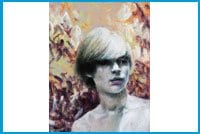if it’s at all possible Paul P has become even more romantic. Known primarily for his tight-cropped close-up drawings, watercolours and paintings of the marginal (but still exceedingly gorgeous) young lads of 1970s gay porn, Queen West’s prodigal son has landed in the upper gallery of the Power Plant not with a bang but with a hushed whisper. Think of the muted sibilance of softly falling rain mists or the silent presence of creeping fog.
The show, entitled Dusks, Lamplights, is taken up mostly with landscapes and atmospherics: loosely rendered bodies of anonymous naked boys frolic in vast dappled washes of muted browns and greys and greens. Paul P conceptualizes the shows title in emotive terms. “Dusk is a very natural, available light that has its own connotations,” he says, “and lamplight is a very high-key/low-key kind of thing. In more emotional senses, too, these atmospheric [watercolours] present a wider sense of distance; they’re more emotional landscapes in a way.”
There is a distinctly European feel to these works which is unsurprising given who Hamilton-born Paul P has been admiring recently. The US-expatriate dandies John Singer Sargent and James MacNeil Whistler are significant influences here. If you’re familiar enough with their work you can see little quotations here and there. There’s a Whistlerian sense of decorousness, poise and artifice about some of the work. There’s something about the apparent looseness of the watercolours that irresistibly recalls Sargent’s efficient, direct methods: a swipe for an arm here, a squiggle for a mouth there.
While these turn-of-the-century artists travelled widely, Paul P, at least in his work, seems to be restricting himself to the murkier parts of the continent. Sulky young lads (still au naturel) pose languidly among the charcoal-black doorways of Venice or drape themselves across a gondola, the brackish waters of the canal lapping gently at their feet. Of course the signature portraits are here as well; in fact that’s one of the show’s more accomplished curatorial masterstrokes. The sharply defined faces, with their sleepy eyes, pillowed lips and each strand of hair carefully etched, punctuate the landscapes like bolts of lightning on a vast horizon. Each illuminates the other.
Apropos the relationship between the two genres that make up the show Paul P says, “[The landscapes] work as emotional extensions of the portraits and they just situate [the work] outside of the portrait paintings, which has its limitations — that the figure is always primary. But here there’s more of an overall environmental light, and those feelings of fog or dusk and the sensory confusion that those things have, the nocturnal ambiance.” There is a distinct communication going on between the show’s chosen genres: the portraits give the landscapes the anchor of a recognizable face and the landscapes lend the portraits a sharper sense of melancholia.
It’s that melancholy that’s so key to Paul P’s work. Most of the critical reception of his paintings and drawings extrapolates from the source material (as opposed to the work itself). The skin-mag models are made to reference lust, naiveté, Stonewall politics or loss of innocence, as if the artist had exhumed the ghosts of pre-AIDS sexuality. This is a kind of nostalgia that Paul P is leery of. “I try to avoid nostalgia,” he says. “Nostalgia is very simplistic. You can’t transfer one thing into another set of realities.”
Paul P flirts with nostalgia, to be sure; aside from the obvious references of the portraits, the landscapes also refer to the touchstones of pre-AIDS sexual identity: the Tadzio-esque longing of his Venice pictures, the dawn-of-photography Arcadian homoeroticism of the washy landscapes. But this thick soup of Stonewall- and pre-Stonewall-era references, as apt as they might be, are both extensions of, and redeemed by, this central feeling of malaise that the artist injects into his work.
“There are some Arcadian moments, but the idea of the light and of the murkiness, it’s more brooding. Arcadian usually has a little more of that crisp heavenly light. A lot of the watercolours are heavily built up, and drifting apart, too. I think it’s less confident than an Arcadian vision. It’s not so utopian,” Paul P says.
The portraits of boys are never sunny. Notice for instance that not one model is smiling, to say nothing of the deep tones — wine-dark maroons, midnight blues, shimmering cross-hatched fields of graphite black — from which the moon-like faces of these pretty young things emerge. Likewise, despite the turn-of-the-century references, the landscapes are nothing close to pure Arcadia: the sombre grey-green fog is too immersive and is always threatening to swallow the boys entirely. Already their bodies are only sketchily visible. And of the Venice pictures, caked with charcoal dust, let’s just say that you can practically smell the cholera.
This is what gives Paul P’s work any kind of power. It doesn’t take much to stir up wistful feelings of the past and if it weren’t for that sense of foreboding, this collection wouldn’t amount to much more than a nostalgia-buff’s slide show. Paul P is not merely interested in examining the prettiness of these boys in their full flower. He wants to remind you of the thorns that lay just behind the bloom. In this respect the show’s title provides a brilliant shorthand for understanding the way in which the artist’s brooding atmospherics work their respective charms. The dim dusks and dark fogs of the landscapes feel damp and pervasive. The lamplight of the portraits, casting steep, sharp shadows, are almost expressionistic in their contrasts. Together they create a pungent sense of decadent romance, like a hallucination brought on by an opium haze.

 Why you can trust Xtra
Why you can trust Xtra


